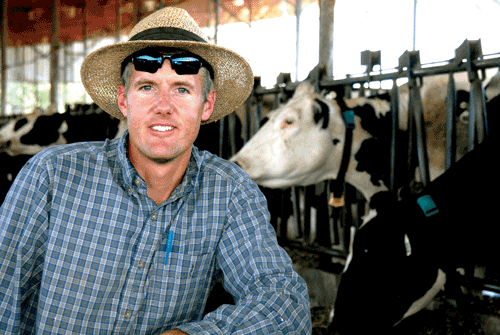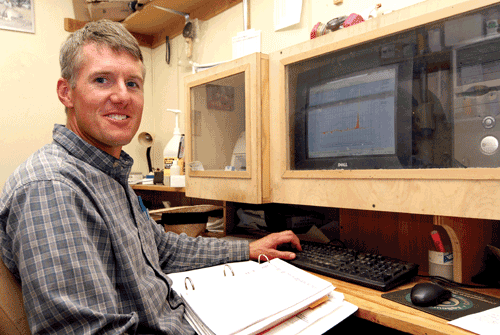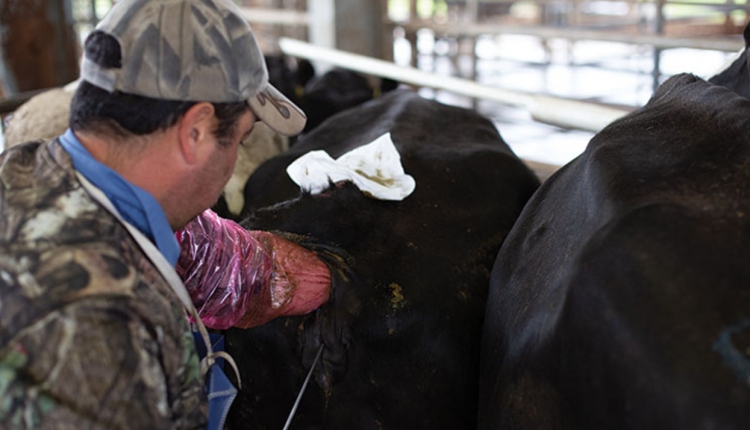
The author, in a pen of early lactation cows that are wearing activity monitoring collars. Cows begin wearing the collars at about 30 days in milk. After they have been confirmed pregnant, the collars are removed, inspected, and then placed on other cows that have recently calved.
I'm the third generation manager of Stewart Farms, our family dairy in Nampa, Idaho. My grandfather started the farm in 1940 with 12 cows and 80 acres. My parents, Jim and Marcella, and my brother Jerry and I, gradually expanded to 500 acres, and a few years ago we peaked at 900 cows with a rolling herd average of 30,000 pounds.
Our cows are housed in free stalls, we've been all-A.I. since it became available, and we've been computerized since PCs became popular in the early 1980s. All of the latest and greatest technology that has been available is what we've used to our benefit, to the point where, in order to be efficient, we've willingly stepped back to 750 cows and 27,500 pounds. Easing back on production and expensive protein has helped us cut feed cost almost $2 per cow per day, which is helping us compete better with the bigger commercial dairies.
I'm usually an early adopter of new science and technology. I'm a person who loves new inventions so I can play with them, see what else I can do with them, and give feedback on how they can be improved. I love technologies and software that let me better measure what the cow is doing, because I think that's the future of dairy management. When something new comes out that has good science behind it, I'm willing to participate in the ones that fit me and my dairy.
Pregnancies are valuable . . .
The biggest obstacles for dairies have always been mastitis, milk production, and reproduction. They are our biggest reasons for culling, too. If a cow is open because she didn't get bred, feed alone costs me a lot more today than just a few years ago. The value of a pregnancy to me today has never been higher. But today, reproduction doesn't worry me near as much because of new technologies for data collection.
This is a huge deal, and the industry is recognizing it. Why? The emphasis now is shifting to factors like productive life, longevity, body size . . . things no one seemed to care about 5 or 10 years ago. Why do we as an industry accept 33 percent first service conception as OK?
When I came home from college and took over the breeding program, tailhead chalking was our primary diagnosis, which was assisted by the herdsman and milkers visually seeing standing heats. We did A.I. once a day, and even dabbled with twice-a-day breeding to get more conception.
When timed A.I. came along it sounded good, but in the back of my mind I just didn't like it. I dabbled with it a little and didn't get good results. I thought to myself, we understand the science and the cycle of the cow, and if I work at it I can get her pregnant. And I was able to run anywhere from 38 to 43 percent first service if I really worked at it. But that included using prostaglandins for anestrous cows and CIDRs, which I hated putting in and taking out.
A couple of years ago I was involved in developing herd management software to measure more about what the cows do. I kind of got sidetracked doing that and my repro work suffered. A little later, a veterinarian came in to evaluate the herd because he was interested in the software and he wanted to offer us his services for a timed A.I. program. His comment was, "Boy, your repro isn't as good as your reputation."
That was a fair criticism, because I had let it slip while my attention had been focused on other things. But it was also a slap, and it hurt. That made me stop and say, "I know I can do a better job because I have done better in the past."
Through the company I was evaluating software for, I was introduced to a heat detection system that measures motion. Not steps, but all activity movements of the cow via a strap around her neck. It not only measures horizontal movements of the cow, but vertical movements and intensity as well. They asked if I'd like to test it out and I said, "You bet I would."
I could see implementing this, and I was familiar with pedometer systems but wasn't sold on them. So here comes this opportunity to test a product that up until then had been marketed to dairies with 150 cows or less, and to prove to us if it works and what needs to be fixed if it doesn't. It was great, because I got a new toy to play with and see if it was designed right and could be applied to a bigger dairy.
I did a trial for a year, and have used it as my stand alone heat detection system for 15 months since. During the trial we tail-chalked and looked to see who was in heat each morning just like we did before, then we came in with our notes. Before we went out to breed we'd see if the computer found anything that we didn't.
Always found more heats . . .
The activity system always found the cows that we found, but it also found cows that, when we went out and looked at them, we would never have caught on our own. The system found enough of those extra animals that I got one extra pregnancy per week.
Every cow that is eligible to be bred, from 30 days in milk on, gets a collar. It takes 7 to 10 days of activity monitoring to learn what each cow's baseline activity is, then we set two thresholds of activity for the computer: a value of 4.7 on the high side and a value of 3.5 on the low side. From then on the computer reports whenever a cow exceeds those thresholds.
The low range is a signal for things like lameness or mastitis, although our milk meters would probably pick also those up when milk production drops. But what I'm focusing on is activity on the high side.
The activity graph shows raw data in 2-hour increments, and trendlines tends to mirror the milking schedule. The system has a built-in logic to ignore short-duration changes, like maybe if a cow gets loose on her way to the parlor and runs back to the free stall barn. In relation to their individual activity baselines, cows' activity spikes regularly go off of the top of the chart when they go into heat. There's no mistaking one when you see it on the screen.
Data gathered at milking . . .
Activity data is gathered constantly by the collar. It's an infrared system like a TV remote, so anywhere she can walk in a single file line, which at my place is going into the milking barn, is where the stored information can be downloaded by the system. The scanner is motion-activated, so when a cow walks under it the scanner turns on and downloads the information from the collar. The collar stores 24 hours of data, so if she somehow missed the last milking, the data will still be in there.
I let cows wear collars until they are confirmed pregnant. Then we take them off and do a little maintenance, because there is some wear and tear that occurs on the strap, and put them on another fresh cow that's ready to go into a breeding pen. We're also currently doing a trial with heifers, but we don't have any data yet about how it works for them.
We use a contract breeder here. When he arrives each morning his heat detection process is to sit at the computer, print out the activity exception report, and then look through it. On a typical day there will be 10 to 15 cows on the report. He brings up each cow's activity graph on the monitor to confirm a heat, checks to see that she's passed our 60-day voluntary waiting period, puts her on his "to breed" list, and then picks the sire he's going to use on her.
If he gets a cow that has an uncertain range of activity – she isn't showing a sharp heat spike, but she's above our activity threshold – then we look at her data for what we call exceptions. If it looks like she might have a follicular wave, which is something we were never able to be aware of before, then we leave her alone until she shows a true heat. If her data looks really odd, we'll go look at her and maybe even check her for being cystic.
So, my breeder spends maybe 10 minutes each morning making a list of who he's going to breed and which sires to use. We don't tail chalk at all anymore. Then he walks through the pens and marks the cows to breed, comes back and loads 2 or 3 guns at a time, and starts breeding. The whole heat detection and breeding process, from printing out the report to putting semen in the cows, takes 45 minutes to an hour.
One point I want to make is, the computer doesn't make decision about who's in heat and who gets bred. It's just a tool that provides information; the decision is still in the hands of the owner or the manager or the breeder. We now have 24-hour activity information on the cows, but how we interpret it dictates what our results are.
This is still something we have to manage, and my current breeder, Jim Griggs, does an excellent job of interpreting the data and making correct breeding decisions. Like anything else, this is a tool that needs to be use correctly; otherwise there's no reason to have it.
In every group of animals there are always some that, no matter what system you use, you're going to find and get pregnant. But also in that population are some low-lyers that are hard to pick up, the ones you never find when you're tail-chalking and the ones you keep pouring drugs and semen into and never quite know when to stop.
This system finds them.
Having been a breeder for 12 years myself, and I thought I was pretty good, I know I'd never find some of those cows the activity system picks up. It showed me I wasn't as good as I thought I was.


54.5 percent conception . . .
We as an industry seem to accept that 33 percent first service conception is OK. I've always considered myself above average at 38 to 43 percent on good months. Well, in 2008 with the activity system we had five months that were over 50 percent, with a high of 54.5 percent. It was unbelievable.
Our average days to first breeding for cows dropped from 90.7 in 2006 to 80.3 in 2008. Average days open in 2006 was 132; the first six months of this year it was 104. In three years projected calving interval has dropped from 14.6 months to 12.6. Services per conception is down from 3.4 to 2.4.
Besides the extra animals that are being found in heat, the other important thing here is timing. Now we have information about when each cow went into heat, so we're getting semen into them at the right time. That's the reason we can achieve 50 percent; it makes all the difference in the world.
We're not only using less semen, but now I have enough confidence in our ability to get cows pregnant that I'm willing to use better semen, and to use better semen for more services.
Heat detection has gotten tremendously easier. Reproduction isn't my number one worry now. It's also helped me on the employee side. We have a lot of people wanting to work on dairies today who lack the background of growing up on a farm and recognizing heats, so we're creating tools to make up for it. Now what we need are people who can read a list and put semen into the cow properly.
The activity system is a stand-alone computer program. It costs $6,000 to $12,000 for installation of readers and other components. It is mandatory that you put in a dual hard drive computer with an automatic backup system. Collars are $95 to $105 each depending on volume. I have 330 collars, most of them are on cows for 75-80 days.
More of my cows getting bred means more calves are getting born and fewer animals are being culled for reproductive failure. The end result is a faster growing herd and more animals than I want to have. It means my voluntary culling is getting more aggressive, and it means I'm selling extra cows. Because I choose to maintain my herd size, I sell groups of 20 to 30 animals a couple of times each year.
There's a lot of disagreement in the industry today about how much a pregnant cow is worth. For me she's worth another lactation and another offspring. It also means I get to keep more of my higher-end cows, because I'm selling off sound lower-end cows. I don't even fear selling pregnant cows, and quite a few of what I sell are pregnant.
I'm also noticing some things I never did before. For instance, in the last group of animals I put together for sale I noticed a few of the same sires kept popping up with the heifers I selected. That was interesting. You just don't know what's going to come to your attention, and I'm excited what the next tool is that may be coming.
Another part of the activity approach to heat detection I like is the consumer perception aspect. The BST experience of consumers being made to fear a technology to the point that we've been forced out of using it by processors is something we need to remember. With timed breeding we have that same feared word – hormones – and many of the same concerns.
Timed A.I. involves a lot of shots, and if consumers were to see all of what is involved it might really scare them. I think we as an industry need to be mindful of what we're doing and how it looks. It's like having a dirty dairy next to the road; you need to be concerned about what your consumer is seeing and thinking.
The nice thing about activity monitoring technology for heat detection is, we're already a step ahead if anyone comes along and says they're going to limit our use of GnRH or prostaglandins.
091025_148W








